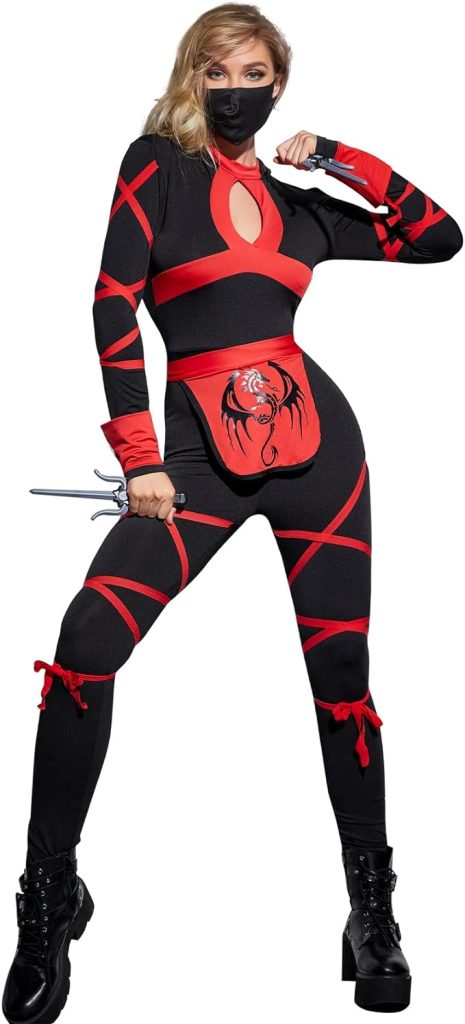The Ninja costume has captivated people’s imaginations for centuries, embodying the enigmatic world of stealth, martial arts, and espionage. In this article, we will explore the origins and historical context of the Ninja costume, delve into the symbolic elements and design that make it iconic, discuss the physical prowess and skill set associated with ninjas, analyze the adaptation and representation of ninjas in popular culture, highlight the craftsmanship and artistry involved in creating a Ninja costume, and provide insights into the enduring fascination with ninjas and their costumes as a symbol of empowerment and intrigue.

I. Origins and Historical Context of the Ninja Costume
1.1 The Shadow Warriors:
The costume originates from the ancient Japanese warriors known as ninjas. These stealthy and highly skilled operatives navigated the shadows, using their expertise in espionage, guerrilla warfare, and intelligence gathering. The Ninja costume was crafted to aid them in their clandestine missions.
1.2 Historical Significance:
The Ninja costume holds historical significance as it represents the ingenuity and adaptability of the ninjas in feudal Japan. In a time of intense conflict, the costume served as a practical tool for concealment and protection, allowing ninjas to blend into their surroundings and execute their missions stealthily.

II. Symbolic Elements and Design of the Iconic Ninja Costume
2.1 Black as the Night:
The Ninja costume is synonymous with the color black. The predominantly black attire, consisting of a mask, tight-fitting garments, and various protective gear, enables ninjas to camouflage themselves effortlessly in the darkness. This symbolism adds an air of mystery and intrigue to the Ninja costume.
2.2 Concealment and Disguise:
The women costume is often designed to conceal the wearer’s identity, emphasizing the essence of anonymity and deception. In addition to the mask, the use of loose-fitting garments and hidden pockets allows the wearer to hide tools and weapons, enabling them to strike swiftly and covertly.

III. Physical Prowess and Skill Set of Ninjas
3.1 Mastery of Martial Arts:
Ninjas were renowned for their mastery of various martial arts disciplines such as Ninjutsu, Kenjutsu, and Shurikenjutsu. The Ninja costume is tailored to accommodate agile movements, providing freedom of motion essential during combat situations, acrobatics, and deception.
3.2 Adaptability and Resourcefulness:
Ninjas possessed exceptional mental and physical adaptability. The Ninja costume, crafted with practicality in mind, reflects their resourcefulness. It enables them to quickly adapt to changing environments, scale walls, blend into crowds, and carry out missions with precision and stealth.

IV. Adaptation and Representation of Ninjas in Popular Culture
4.1 Influence on Media and Entertainment:
The Ninja costume has left an indelible mark on popular culture, influencing books, films, comics, and video games. The depiction of ninjas in various forms of media has heightened their intrigue and created a lasting fascination that has captured the imaginations of people worldwide.
4.2 Modern Interpretations:
While the historical Ninja costume remains iconic, modern adaptations have allowed for creative reinventions. Contemporary interpretations infuse elements of fantasy, cyberpunk, or steampunk aesthetics, showcasing the versatility and adaptability of the Ninja costume in different genres and artistic expressions.
V. Craftsmanship and Artistry in Creating a Ninja Costume
5.1 Tailoring and Fabrication:
Crafting a Ninja costume requires meticulous attention to detail. Skilled costumers focus on precise tailoring, ensuring the garment fits comfortably and allows for ease of movement. Lightweight yet durable fabrics, such as breathable synthetics or natural fibers, contribute to the overall functionality and authenticity of the costume.
5.2 Weapons and Props:
The craftsmanship of Ninja costumes extends to the creation of weapons and props. From handcrafted shurikens to intricately designed katana swords, attention is given to the accuracy of details, ensuring they resemble their historical counterparts or, in fictional adaptations, align with the intended aesthetic.

VI. Enduring Fascination with Ninjas and their Costumes
6.1 Empowerment and Mystique:
The enduring fascination with ninjas and their costumes lies in the combination of empowerment and mystique they evoke. Dressing as a ninja allows individuals to tap into the strength, agility, and mystique associated with these legendary warriors, experiencing a sense of empowerment and unleashing their inner warrior spirit.
6.2 Enigmatic Appeal:
The enigmatic appeal of the Ninja costume is timeless. It embodies secrecy, quick thinking, and the embodiment of a hidden power. The enduring fascination with ninjas and their costumes remains a testament to their captivating qualities and the allure of a world shrouded in shadows and mystery.
The Ninja costume continues to captivate people’s imaginations through its origins, symbolic elements, and representation in popular culture. As a costume steeped in history, it evokes notions of stealth, martial artistry, and espionage. The craftsmanship and artistry behind creating a Ninja costume further enhance its allure and authenticity. Whether in historical or modern interpretations, the enduring fascination with ninjas and their costumes reflects our ongoing fascination with untold stories, empowerment, and the enigmatic world of the shadows.
